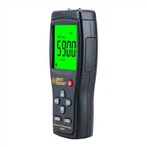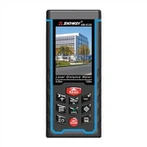Ultrasonic Range Finder Design and Application Analysis
This paper uses the relationship between distance and time in ultrasonic transmission, and uses AT89C51 single-chip microcomputer for control and data processing, and designs an ultrasonic rangefinder that can measure the distance between two points. The rangefinder is mainly composed of an ultrasonic transmitter circuit, an ultrasonic receiver circuit, a single-chip microcomputer control circuit, an ambient temperature detection circuit and a display circuit. Using the designed ultrasonic rangefinder, different distances are tested, and a detailed error analysis is carried out.
Ultrasonic distance measuring microcontroller temperature sensor
With the development of society, people have higher and higher requirements for distance or length measurement. Ultrasonic ranging is paid more and more attention to because of its non-contact measurement and relatively high precision. The ultrasonic range finder designed in this paper can test different distances and perform detailed error analysis.
1. Design principle
Ultrasonic rangefinder is based on the characteristics of ultrasonic waves reflected back when encountering obstacles. The ultrasonic transmitter emits ultrasonic waves in a certain direction, and starts timing at the same time as the emission. The ultrasonic waves propagate in the air, and return immediately when encountering obstacles on the way, and the ultrasonic receiver immediately interrupts and stops timing when it receives the reflected wave. By continuously detecting the echoes reflected by obstacles after the generated waves are emitted, the time difference T between the emitted ultrasonic waves and the received echoes is measured, and then the distance L is calculated. The basic ranging formula is: L=(△t/2)*C
Where L - the distance to be measured
T - the time interval between the transmitted wave and the reflected wave
C——The speed of sound of ultrasonic waves in air, which is taken as 340m/s at room temperature
After the speed of sound is determined, L can be obtained by measuring the round-trip time of the ultrasonic waves.
2. Ultrasonic range finder design goal
Measuring distance: within 5 meters; the distance between two points can be displayed correctly through the LED; the error is less than 5%.
3. Data measurement and analysis
1. Data measurement and analysis
Due to the limitations of the actual measurement work, six distances of 30cm, 50cm, 70cm, 80cm, 90cm, and 100cm below one meter were selected for measurement, and each distance was measured seven times continuously to obtain the measurement data (temperature: 29°C), as shown in the table. It can be seen from the data in the table that the measured value is generally a few centimeters larger than the actual value, but the accuracy of continuous measurement is relatively high.
For each set of measured data, a maximum value and a minimum value are removed, and then the average value is calculated, which is used as the final measurement data, and finally comparative analysis is carried out. This processing of data also has a certain degree of science and rationality. From the data in the table, although the temperature compensation has been carried out on the ultrasonic wave, the relative error is relatively large in the measurement of a relatively short distance. Especially for the distance measurement of 30cm and 50cm, the relative errors reached 5% and 4.8% respectively. But from all the measurement results, the error of this design is relatively small and relatively stable. The blind area of this design is about 22.6cm, which basically meets the design requirements.
2. Error analysis
The ranging error mainly comes from the following aspects:
(1) There is a certain angle between the ultrasonic transmitting and receiving probe and the measured point, which directly affects the maximum value of the measurement distance; (2) The ultrasonic echo sound intensity is directly related to the distance to be measured, so the actual measurement It is not necessarily a zero-crossing trigger of an echo; (3) Due to the crude tools, the actual measurement distance also has errors. There are many factors that affect the measurement error, including field environment interference, time base pulse frequency and so on.
4. Application Analysis
The use of ultrasound to measure the ground distance in the atmosphere is a technology that has been formally applied only after the development of modern electronic technology. Since ultrasonic ranging is a non-contact detection technology, it is not affected by light, the color of the measured object, etc., and can be used in harsh environments. (such as containing dust) has a certain adaptability. Therefore, it is extremely versatile. For example: surveying and mapping topographic maps, building houses, bridges, roads, digging mines, oil wells, etc., using ultrasonic waves to measure ground distances is achieved using photoelectric technology. The advantages of ultrasonic rangefinders are: the cost of the instrument is lower than that of light wave rangefinders Low, labor-saving, easy to operate.
Ultrasonic rangefinders are also used in advanced robot technology. The ultrasonic source is installed on the robot, which continuously emits ultrasonic waves to the surroundings and simultaneously receives echoes reflected by obstacles to determine the robot's own position, and uses it as a sensor to control the robot. computer and so on. Because ultrasonic waves are easy to directional emission, good directionality, and easy control of intensity, its application value has been widely valued.
In a word, it can be seen from the above analysis that using ultrasonic ranging has many advantages in many aspects. Therefore, the research of this topic is very practical and commercially valuable.






